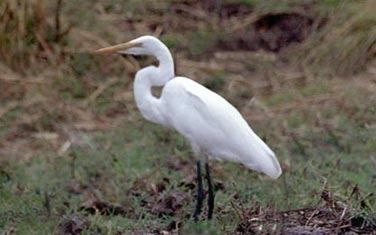This section of the Dandenong Creek Parks was very well maintained, in terms of pathways, signage, etc. In particular, the extensive wooden "board walks" with their wire netting (non-slip) surface were very impressive. Clearly in such a wet and shady gully this is a necessary precaution, but it is good to see it being used. And obviously the park is heavily used by the public, which is good to see.
In fact it is a pretty good section of bushland, with a nearly continuous canopy of trees and undergrowth. The dominant trees are the Yarra Gum (apparently). The understorey is mostly Silver Wattle, and Melaleuca scrub in the wetter areas. The ground cover is almost entirely composed of weeds unfortunately, "Wandering Jew" (Tradescantia) and Ivy and Honeysuckle, and the ubiquitous Onion Weed. In the warm spring morning air, the smell of the Onion Weed was almost overpowering.
The problem with the dense ground cover is that it excludes small native plants, such as Ground Orchids and small ferns, from getting any light, so eventually they will die out (locally), leaving only the green mat of introduced weeds. Still, I do not envy the "Friends of the Dandenong Valley Parklands" their task of coping with the legacy of over 160 years of of introduced weeds, since first settlement of this area.
The Silver Wattles and many of the tall Eucalypts are showing severe stress. Huge numbers have died, apparently from insect attack (notably the wattles, which all have the obvious marks of moth larvae having bored under their bark, and ring-barked the trees).
There were plenty of birds in evidence: Brown Thornbills, White-browed Scrubwrens, Grey Fantails, Yellow Robins. I also came face to face with a female Spotted Pardalote, who was at least as surprised as I was to find herself sitting just a few metres from me (too close for the camera to focus!) Up in the tree tops, the large Honeyeaters fought it out for dominance. The aggressive Bell Birds (a type of Honeyeater, related to the Noisy Miner) challenging the larger Red Wattlebirds. Then there are the Rainbow Lorikeets. These aggressive birds fly, screaming, through the tree tops, and compete for nesting sites against other Parrots, especially the Crimson Rosellas. However, as they are predominantly nectar feeders, they would compete (for food) with the Honeyeaters.
Large White Egret
 Once I had seen most of what I could expect to see there, I crossed over High Street Road (Only in Melbourne would one find such a street name.) This took me into Bushy Park, which turned out to be almost totally devoid of bush (at least in its southern section), which is where the main area of Wetlands is located. Here there was a "Hide" (a "bird hide" is a shelter where the bird watcher can go and sit quietly, and observe waterbirds - without scaring them). Once inside the "Hide", I could clearly see a number of White Ibises, A White-fronted Heron, a Large White Egret (which caught a fish while I was watching it), Grey Teal and Chestnut Teal, and Black Duck. This pool was much more active with wildfowl than a similar facility at Jells Park.
Once I had seen most of what I could expect to see there, I crossed over High Street Road (Only in Melbourne would one find such a street name.) This took me into Bushy Park, which turned out to be almost totally devoid of bush (at least in its southern section), which is where the main area of Wetlands is located. Here there was a "Hide" (a "bird hide" is a shelter where the bird watcher can go and sit quietly, and observe waterbirds - without scaring them). Once inside the "Hide", I could clearly see a number of White Ibises, A White-fronted Heron, a Large White Egret (which caught a fish while I was watching it), Grey Teal and Chestnut Teal, and Black Duck. This pool was much more active with wildfowl than a similar facility at Jells Park.Incidentally, many of the birds I observed were collecting nesting materials. I was surprised, I would have expected them to be have eggs or young at this stage of the season, but their behaviour was very obviously nest building. A White-plumed Honeyeater was raiding the fluffy seedheads of reeds in the creek to line its nest in the top of a Melaleuca overhanging the Dandenong Creek, right beside the footbridge beside Drummies Bridge, on High Street Road. Other birds which were obviously nesting were Welcome Swallow, White-browed Scrubwren, Red-browed Finch, Blue Wren, and all the Parrots.
This was a pleasant morning's outing for me. Congratulations to Parks Victoria for their on-going work in this series of parks, in an important wetland environment.

2 comments:
its crap!!!!!!!!!!
Dear Anonymous,
I tried to write a balanced "review" of the Dandenong Creek Parks. Sure I acknowledged the weeds, (and the difficulty faced by the Parks administrators and the "Friends") But, on the positive side, there were many interesting birds.
Perhaps you might volunteer to help the Friends weed the Parks, and bring them back to what they should be like.
It is the history of 150 years of European settlement.
Denis
Post a Comment